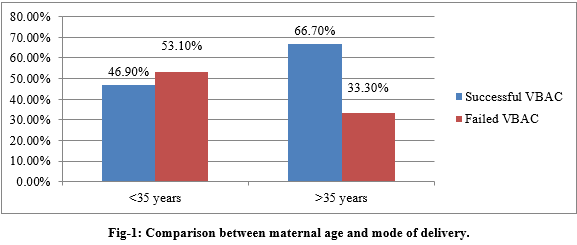Factors affecting the success rate of vaginal birth after cesarean section
Abstract
Introduction: The success rate of vaginal birth after cesarean section (VBAC) varies among institutions and health care providers. It is also affected by various antepartum, intrapartum factors as well as the difference in the obstetric population.
Objectives: The main aim of the study is to determine the factors that affect the success rate of vaginal birth after cesarean section. This will help us to choose the right patients for VBAC thereby decreasing the complications of an emergency cesarean section.
Methods: This is a prospective, cohort study done over a period of twelve months. Based on the patient's preference a total of 211 women were divided into two groups either a trial of labor after cesarean section (TOLAC) or elective repeat cesarean section (ERCS) group. VBAC group was compared with the failed trial of labor group to determine the factors affecting the success rate.
Result: The success rate of VBAC was found to be 47.9%. About 15% of failed VBAC was due to the tendency to abandon a TOLAC midway. The success rate of VBAC increased in women with previous vaginal delivery and in those who went into spontaneous labor. Epidural was found to be safe to use in the trial of the labor group.
Conclusion: Women with factors that increase the likelihood for vaginal delivery following cesarean section should be motivated well and referred to a tertiary center to improve the success rate as well as to reduce the maternal and fetal morbidity
Downloads
References
Vaginal Birth After Cesarean Trends: Which Way Is the Pendulum Swinging?. Obstet Gynecol Clin North Am. 2017;44(4):655-666. doi: https://doi.org/10.1016/j.ogc.2017.08.006.
Landon MB, Hauth JC, Leveno KJ, Spong CY, Leindecker S, Varner MW, Moawad AH, et al for the National Institute of Child Health and Human Development Maternal-Fetal Medicine Units Network. Maternal and perinatal outcomes associated with trial of labour after prior caesarean delivery. N Engl J Med. 2004;351(25):2581-2589. doi: https://doi.org/10.1056/nejmoa040405.
Stone C, Halliday J, Lumley J, Brennecke S. Vaginal birth after caesarean (VBAC): a population study. Paediatr Perinat Epidemiol. 2000;14(4):340-348. doi: https://doi.org/10.1046/j.1365-3016.2000.00299.x.
McMahon MJ. Vaginal birth after caesarean. Clin Obstet Gynecol. 1998;41(2):369-381. doi: https://doi.org/10.1097/00003081-199806000-00018.
ACOG Practice Bulletin No. 205: Vaginal Birth After Cesarean Delivery. Obstet Gynecol. 2019;133(2):e110-e127. doi: https://doi.org/10.1097/AOG.0000000000003078.
Lehmann S, Baghestan E, Børdahl PE, Irgens LM, Rasmussen S. Low risk pregnancies after a cesarean section: Determinants of trial of labor and its failure. PLoS ONE 2020;15(1):e0226894. doi: https://doi.org/10.1371/journal.pone.0226894.
American Academy of paediatrics and the American College of Obstetricians and Gynecologists: guidelines for perinatal care, 6th edition, 2007.
Boulvain M, Fraser WD, Brisson-Carroll G, Faron G, Wollast E. Trial of labour after caesarean section in sub-Saharan Africa: a meta-analysis. Br J Obstet Gynaecol. 1997;104(12):1385-1390. doi: https://doi.org/10.1111/j.1471-0528.1997.tb11008.x.
Landon Grobman WA, Lai Y, Landon MB, Spong CY, Rouse DJ, Varner MW, et al. The change in the rate of vaginal birth after caesarean section. Paediatr Perinat Epidemiol. 2011;25(1):37-43. doi: https://doi.org/10.1111/j.1365-3016.2010.01169.x.
Durnwald CP, Rouse DJ, Leveno KJ, Sponge CY, Macpherson C, Varner MW, et al. The Maternal-Fetal Medicine Units Caesarean Registry: Safety and efficacy of a trial of labour in preterm pregnancy after a prior caesarean delivery. Am J Obstet Gynecol. 2006;195(4):1119-1126. doi: https://doi.org/10.1016/j.ajog.2006.06.047.
Quinones JN, Stamilio DM, Paré E, Peipert JF, Stevens E, Macones JA. The effect of prematurity on vaginalbirth after caesarean delivery: Success and maternal morbidity. Obstet Gynecol. 2005;105(3):519-524. doi: https://doi.org/10.1097/01.aog.0000153493.15922.85.
Sentilhes L, Vayssière C, Beucher G, Tharaux CD, Deruelle P, Diemunsch P, et al. Delivery for women with a previous cesarean: guidelines for clinical practice fromthe French College of Gynecologists and Obstetricians (CNGOF). Europe J Obstet Gynecol Reproduct Biol. Elsevier, 2013;170(1):25-32. doi: https://doi.org/10.1016/j.ejogrb.2013.05.015.
Landon MB, Leindecker S, Spong CY, Mercer BM, Gabbe SG for the National Institute of Child Health and Human Development Maternal-Fetal Medicine Units Network . The MFMU Caesarean Registry: factors affecting the success of trial of labour after previous caesarean delivery. Am J Obstet Gynecol. 2005;193(3):1016-1023. doi: https://doi.org/10.1016/j.ajog.2005.05.066.
Silver RM, Landon MB, Rouse DJ, Leveno KJ, Sponge CY, Thom EA et al National Institute of Child Health and Human Development Maternal-Fetal Medicine Units Network. Maternal morbidity associated with multiple repeat caesarean deliveries. Obstet Gynecol. 2006;107(6):1226-1232.
Chauhan SP, Martin JN Jr, Henrichs CE, Morrison JC, Magann EF. Maternal and perinatal complications with uterine rupture in 142,075 patients who attempted vaginal birth after caesarean delivery: A review of the literature. Am J Obstet Gynecol. 2003;189(2):408-417. doi: https://doi.org/10.1067/s0002-9378(03)00675-6.
Guise J-M, Eden K, Emeis C, Denman MA, Marshall N, Fu R, Janik R, Nygren P, Walker M, cDonagh M. Vaginal Birth After Caesarean: New Insights. Evidence Report/Technology Assessment No.191. (Prepared by the Oregon Health & Science University Evidence-based Practice Center under Contract No.290-2007-10057-I). AHRQ Publication No. 10-E003. Agency for Healthcare Research and Quality, Rockville, MD2010. http://www.ahrq.gov/clinic/tp/cesarreqtp.htm#Report.
Peaceman AM, Gersnoviez R, Landon MB, Sponge CY, Leveno KJ, Varner MW et al National Institute of Child Health and Human Development Maternal-Fetal Medicine Units Network. The MFMU caesarean registry: Impact of fetal size on trial of labour success for patients with previous caesarean for dystocia. Am J Obstet Gynecol 195:1127, 2006;195(4):1127-1131. doi: https://doi.org/10.1016/j.ajog.2006.06.003.
Place, K., Kruit, H., Tekay, A, Heinonen S, Rahkonen L. Success of trial of labor in women with a history of previous cesarean section for failed labor induction or labor dystocia: a retrospective cohort study. BMC Pregn Childbirth. 2019;19:176. doi: https://doi.org/10.1186/s12884-019-2334-3.

Copyright (c) 2020 Author (s). Published by Siddharth Health Research and Social Welfare Society

This work is licensed under a Creative Commons Attribution 4.0 International License.


 OAI - Open Archives Initiative
OAI - Open Archives Initiative



















 Therapoid
Therapoid

